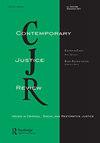‘Communities are not at the periphery, rather they are at the centre of Restorative Justice in BC’: an inquiry into the praxis of Restorative Justice in British Columbia, Canada
Q2 Social Sciences
引用次数: 5
Abstract
ABSTRACT There has been ebbs and flows, since 1982, with the growth of Restorative Justice (RJ) practices in British Columbia (BC), Canada. To date there are more than seventy plus organizations that offers RJ practices in BC. Using in-depth key informant interviews, along with surveys, this research seeks to understand the genesis and praxis of RJ in BC. This study finds that the local community’s involvement was of paramount importance to the growth of restorative justice. Key findings include the contribution of Community Justice Initiative Langley, Community Accountability Programs and SFU’s Centre for Restorative Justice. A number of emergent themes are discussed in the paper that include the role of the written RJ script, and standardization. The findings are significant for a number of reasons, first of all, it reveals the role of community, government and university collaboration. Secondly, emergent themes discussed in this paper illustrate the tensions within RJ praxis in BC where learning and growth are creating new understanding and insight. A detailed analysis on standardization debate and scripted vs non-scripted model of RJ are also discussed. This paper concludes that future research needs to focus on the relationship between restorative justice and Indigenous justice in BC.“社区不是处于边缘,而是处于不列颠哥伦比亚省恢复性司法的中心”:加拿大不列颠哥伦比亚省对恢复性司法实践的调查
自1982年以来,随着加拿大不列颠哥伦比亚省(BC)恢复性司法(RJ)实践的发展,恢复性司法经历了起起落落。到目前为止,在不列颠哥伦比亚省有超过70个组织提供RJ实践。通过深入的关键线人访谈和调查,本研究试图了解不列颠哥伦比亚省RJ的起源和实践。本研究发现,当地社区的参与对恢复性司法的发展至关重要。主要发现包括社区司法倡议兰利,社区问责计划和SFU的恢复性司法中心的贡献。本文讨论了许多新出现的主题,包括编写的RJ脚本的角色和标准化。这一发现意义重大,原因有很多,首先,它揭示了社区、政府和大学合作的作用。其次,本文讨论的新兴主题说明了不列颠哥伦比亚省RJ实践中的紧张关系,其中学习和成长正在创造新的理解和见解。对RJ的标准化争论和脚本化与非脚本化模型进行了详细的分析。本文认为,未来的研究需要关注不列颠哥伦比亚省恢复性司法与土著司法之间的关系。
本文章由计算机程序翻译,如有差异,请以英文原文为准。
求助全文
约1分钟内获得全文
求助全文

 求助内容:
求助内容: 应助结果提醒方式:
应助结果提醒方式:


